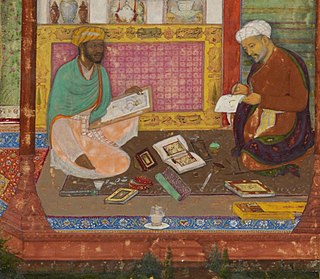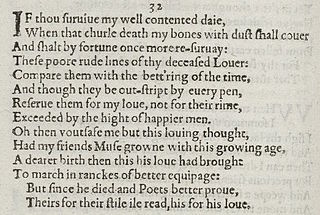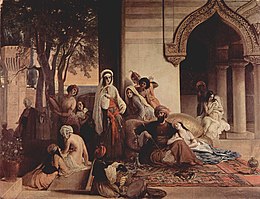
Poetry is a form of literature that uses aesthetic and rhythmic qualities of language—such as phonaesthetics, sound symbolism, and metre—to evoke meanings in addition to, or in place of, the prosaic ostensible meaning.
In modern literary criticism, more common with genre fiction, conceit often means an extended rhetorical device, summed up in a short phrase, that refers to a situation which either does not exist, or exists rarely, but is needed for the plot.

Shakespeare's sonnets are poems that William Shakespeare wrote on a variety of themes. When discussing or referring to Shakespeare’s sonnets, it is almost always a reference to the 154 sonnets that were first published all together in a quarto in 1609; however there are six additional sonnets that Shakespeare wrote and included in the plays Romeo and Juliet, Henry V and Love's Labour's Lost.
Blason is a form of poetry. The term originally comes from the heraldic term "blazon" in French heraldry, which means either the codified description of a coat of arms or the coat of arms itself. The Dutch term is Blazoen, and in either Dutch or French, the term is often used to refer to the coat of arms of a chamber of rhetoric.

In Islamic cultures of the Middle East, North Africa, Sicily and South Asia, a Diwan is a collection of poems by one author, usually excluding his or her long poems (mathnawī). These poems, frequently sung or set to music, were often composed and collected in the imperial courts of various sultanates and were very well known for their ability to inspire.

Sonnet 18 is one of the best-known of the 154 sonnets written by the English playwright and poet William Shakespeare.

William Shakespeare's Sonnet 130 mocks the conventions of the showy and flowery courtly sonnets in its realistic portrayal of his mistress.
Sonnet 17 is one of 154 sonnets written by the English playwright and poet William Shakespeare. It is the final poem of what are referred to by scholars as the procreation sonnets with which the Fair Youth sequence opens.

Sonnet 19 is one of 154 sonnets published by the English playwright and poet William Shakespeare in 1609. It is considered by some to be the final sonnet of the initial procreation sequence. The sonnet addresses time directly, as it allows time its great power to destroy all things in nature, but the poem forbids time to erode the young man's fair appearance. The poem casts time in the role of a poet holding an “antique pen”. The theme is redemption, through poetry, of time's inevitable decay. Though there is compunction in the implication that the young man himself will not survive time’s effects, because redemption brought by the granting of everlasting youth is not actual, but rather ideal or poetic.

Sonnet 21 is one of 154 sonnets written by the English playwright and poet William Shakespeare and is part of the "fair youth" sequence. Like Sonnet 130, it addresses the issue of truth in love, as the speaker asserts that his lines, while less extravagant than those of other poets, are more truthful. Contrary to most of Shakespeare's sonnets, Sonnet 21 is not addressed to any one person. There is no second person, no overt "you" or "thou" expressed in it.

Sonnet 32 is one of 154 sonnets written by the English playwright and poet William Shakespeare. It is a member of the Fair Youth sequence, in which the poet expresses his love towards a young man. The writer is reflecting on a future in which the young man will probably outlive him. The writer takes a melancholy tone, telling the young man to remember the writer not because of the strength of the sonnets, but because the love that has been shown to the young man far surpasses any love shown by another poet.

Shakespeare's Sonnet 35 is part of the Fair Youth sequence, commonly agreed to be addressed to a young man; more narrowly, it is part of a sequence running from 33 to 42, in which the speaker considers a sin committed against him by the young man, which the speaker struggles to forgive.
The poetry of the Ottoman Empire, or Ottoman Divan poetry, is fairly little known outside modern Turkey, which forms the heartland of what was once the Ottoman Empire. It is, however, a rich and ancient poetic tradition that lasted for nearly 700 years, and one whose influence can still be felt in the modern Turkish poetic tradition.

The sonnets of Petrarch and Shakespeare represent, in the history of this major poetic form, the two most significant developments in terms of technical consolidation —by renovating the inherited material—and artistic expressiveness—by covering a wide range of subjects in an equally wide range of tones. Both writers cemented the sonnet's enduring appeal by demonstrating its flexibility and lyrical potency through the exceptional quality of their poems.

Sonnet 71 is one of 154 sonnets written by the English playwright and poet William Shakespeare. It's a member of the Fair Youth sequence, in which the poet expresses his love towards a young man. It focuses on the speaker's aging and impending death in relation to his young lover.
Metiochus and Parthenope is an Ancient Greek novel that, in a translation by the eleventh-century poet ‘Unṣurī, also became the Persian romance epic Vāmiq u ‘Adhrā, and the basis for a wide range of stories about the 'lover and the virgin' in medieval and modern Islamicate cultures.
Khorāsānī style was a movement in Persian poetry associated with the court of the Ghaznavids, associated with Greater Khorasan.
The Persian term for riddle is chīstān, literally 'what is it?', a word that frequently occurs in the opening formulae of Persian riddles. However, the Arabic loan-word lughaz is also used. Traditional Persian rhetorical manuals almost always handle riddles, but Persian riddles have enjoyed little modern scholarly attention. Yet in the assessment of A. A. Seyed-Gohrab, 'Persian literary riddles provide us with some of the most novel and intricate metaphors and images in Persian poetry'.
















